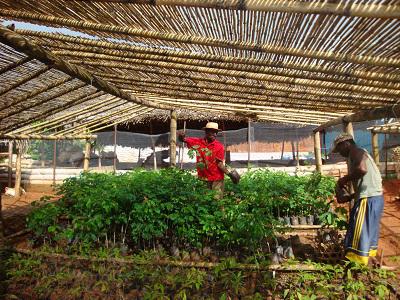Alison Cameron
Other projects
1 Jun 2003
Biodiversity Assessment and Strategic Conservation Planning, for the Riparian Forests of the Spiney Forest Ecoregion of Madagascar
This project aims to assess the biodiversity value of reforestation projects using native tree species, providing results to support regional and national conservation and forestry planning.

MBP tree nursery in Kianjavato. © Alison Cameron.
The project will:
Quantify the effects of reforestation on amphibian, reptile and butterfly biodiversity by conducting surveys of closed canopy forest, recently reforested areas (3 years ago), and areas scheduled for reforestation.
Establish simple, quantitative, repeatable methodologies, to be repeated through future years to assess changes in biodiversity as the reforested areas mature. The survey methods could also be replicated across other reforestation sites, for comparison, throughout the rainforest biome.
Provide information to the Kianjavato community on the value of their reforestation areas for biodiversity.
Inform conservation scientists, managers, and policy makers (through talks at meetings, project reports, and peer reviewed publications) about the extent to which reforestation efforts can support the nation’s biodiversity conservation targets.
Activities and Methodology:
Three categories of habitat; closed canopy forest, reforested areas, and land scheduled to be reforested will be compared. Standardized surveys of amphibians, reptiles and butterflies, will be conducted along 100m transects. Transects will be located in patches of habitat with similar elevations, slopes and aspects. 11 trapping stations will be set 10m apart along each transect. Buckets will be dug into the ground, with a drift fence to guide amphibians and reptiles into the buckets. Blendon butterfly traps baited with fermented fruit will also be hung at each station. All traps will be checked twice per day and per night, for 5 days and nights.
In addition to trapping nocturnal survey teams will walk one way along the transect using spotlights to find and identify chameleons (which are pale and immobile in the dark), returning down the transect actively searching for amphibians and reptiles. Each reptile, amphibian or butterfly captured or observed will be identified to species level and the life stage will be recorded. Photographs, measurements, and DNA samples will be taken where necessary to confirm identifications. Species richness, relative abundance, and diversity indices for the three habitats, will be used to test for differences between the habitats per taxonomic group.
Outcomes:
The project is expected to inform the planning and monitoring of a range of reforestation programs which are commonly implemented under a range of Payment for Ecosystem Services (PES) programs (one example is REDD+), or are paid for by mining companies who have to restore mining land. Many of these projects incorporate biodiversity goals but are often optimistic from the biodiversity perspective and the biodiversity outcomes are rarely well quantified. Our project results will assist with setting goals for biodiversity restoration in reforestation projects, and our simple but robust methods will be available for use by such projects and our results will be available for comparison.